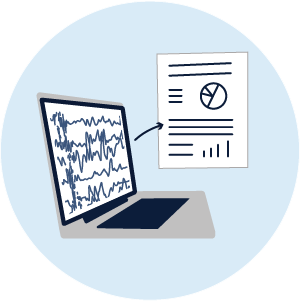Face-to-Face Curriculum

In this unit, students work in small groups to experience the processes of authentic research including drafting testable questions, conducting background research, analyzing results, and writing a scientific paper to share their findings. Students choose their own variables and conduct experiments on different cognitive functions. Teachers are encouraged to support students in publishing their papers or final presentations at the school-wide, local, or state level.
1. Engage & Explore: Developing Testable Questions
Students will explore the process of developing a testable question. Students will begin with a question asking activity in which they make observations and ask questions about an intriguing object. Students will then brainstorm neuroscience topics of interest and be grouped based on these interests. Groups will then work together to develop a testable question to inform their work throughout unit 2.
| View in New Tab Copy to Google Drive |
View in New Tab Copy to Google Drive |
2. Explore: Background Research and Drafting Introductions
Students will be introduced to the parts of a scientific research paper. This will aid in student understanding of research papers they read during their background research and will help inform student writing. Throughout unit 2, students will draft scientific papers to share their experimental findings for a more authentic research experience. In this lesson, students will conduct informal background research and draft introductions for their scientific papers as a group.
| View in New Tab Copy to Google Drive |
View in New Tab Copy to Google Drive |
3. Explore: Background Research and Developing Hypotheses
Students will work in their group to conduct formal background research and develop an initial hypothesis. Students will use the background research organizer to help them. This lesson spans approximately three 45-minute class periods; however, teachers can choose to require a certain number of sources and may allow students fewer or additional research days as they see fit.
| View in New Tab Copy to Google Drive |
View in New Tab Copy to Google Drive |
4. Explain: Research Study Proposal
Students will draft the next section of their scientific paper: methods and materials. Using this draft as well as their background research from the previous lesson and introduction drafts, students will develop a formal research proposal using an organizer to submit for teacher approval.
| View in New Tab Copy to Google Drive |
View in New Tab Copy to Google Drive |
5. Elaborate: Data Collection and Analysis
Students will use this time to customize their experiments and execute their experiments while collecting data. Students will also look through and analyze the behavioral data they collected from their experiment.
| View in New Tab Copy to Google Drive |
View in New Tab Copy to Google Drive |
6. Evaluate: Discussion and Final Paper
Students will draft the discussion portion of their paper to convey the findings of their experiment. Students will then write a final scientific paper using each section they have drafted thus far: introduction, methods and materials, results and discussion. Teachers can publish student papers in a class or school-wide journal.
| View in New Tab Copy to Google Drive |
View in New Tab Copy to Google Drive |
7. Evaluate: Student Presentations
In this lesson, students will present their findings using a presentation style of their choice. This may include slides, a Youtube video, a Snapchat video, etc. Presentations can be done in class as well as at the school-wide or community level (local news, school news, school assembly, etc.)
| View in New Tab Copy to Google Drive |
View in New Tab Copy to Google Drive |